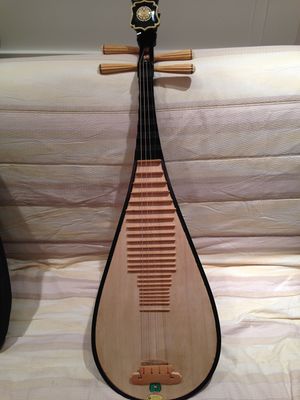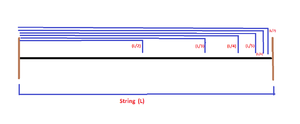Course:PHYS341/Archive/2016wTerm2/Inharmonicity in Pipa Strings

The Pípa is a Chinese stringed instrument in the Lute family (Fig.1) . There are many variations of this instrument consisting of two to six strings, and a smaller bodied variation known as the Liǔqín
History
First prototypes of the Pípa were found in China. These prototypes dated back to 386 - 534 AD, during the Northern Wei Dynasty[1]. It is played as a solo instrument, or can be played with an orchestra. The Pípa is usually played at ceremonial events and performances, or at formal imperial meetings; the Pipa was a popular instrument to play. In modern days, it is still popular choice of instrument to learn and it still holds traditional values to the chinese art and social culture.
Instrument

The Pípa is similar to most other instruments in the Lute family. It is comprised of a pear-shaped soundbox with a round back shaped like a bowl. It has a neck which ranges from having 12 to 26 frets. Most common Pípa consist of four strings tuned to A3, D4, E4, A4 (Fig.2). Traditionally, Pípa strings were made of silk but more modern Pípa constructions uses wound-steel or nylon. These strings are connected to the bridge on the sound board, and on the tuning pegs at the end of the neck. A nut holds the string before the tuning pegs to keep the strings in their place, and to prevent excess vibrations.
Pípa Acoustics
Wood
The body of the Pípa is comprised mainly of wood. The wood type used for backing frame and soundboard ranges between angiosperm trees and gymnosperm trees. Both wood types have a wide range of density and strength that is used for constructing the Pípa. The soundboard is usually comprised of a wood material that is soft and light[2] . Most commonly wood species used as soundboards come from Paulownia sp, an angiosperm. The backing frame is comprised of a wood material that has dense and strong properties to hold the instrument together. It is preferred that the soundboard is made from softwood due to its light and high resonant quality, and in relation to the backing the quality of hardwood being stiff and heavy allows it to act as a frame to support the tension from the stings[3]
Strings
Traditionally, pípa strings were silk strings which were lighter and thinner compared to modern day lute strings. Newer string material, such as steel alloys, nylon, and a combination of both material, became stronger than silk strings and therefore it could endure more tension, as a result the sound intensity can increase[4]. Newer string material would also last longer. Traditionally musicians would use a large wooden plectrum to pluck the strings, however modern Pípa musicians would either use a plectrum or their fingers, sometimes even using finger picks. The act of plucking creates a transfer wave that travels along the string, which then oscillates and produces the sound[5]. Another factor of sound is that the instrument does not have perfectly rigid supports, allowing the vibrational energy of the plucked string to transfer throughout the soundboard, and the soundboard then radiates the sound.
Harmonics & Inharmonic Series

The harmonics series is the sequence of partials, where the frequencies are integer multiples of the lowest base frequency (fundamental frequency). Given a length of a fixed string (L), the string would have a harmonic series if played at the positions L/2, L/3, L/4, L/5, L/6, and L/7[6] (Fig.3). Therefore the lowest harmonic is the base frequency and the other positions would produce overtones
Inharmonicity is the phenomenon where the overtones do not follow the base frequency's integer multiple. There is not distinct ratio in the frequency intervals of a given the base frequency.
Inharmonicity phenomenon in Pípa strings
The act of plucking or striking a string creates a phenomenon of inharmonicity. Inharmonicity is also affected by string composition; the lower the tension, the thicker the diameter, and the less flexible the string, the more prevalent inharmonicity becomes. When playing the Pípa, Inharmonicity is prevalent as it gives the instrument its unique sound, however the musician can be affected by tuning since it is studied that pitch perception is affected by the intensity of inharmonicity [7]. Especially when higher notes are played, there is a greater result in inharmonicity. Higher notes played on the pipa leads to an uneven integer multiples of frequencies, resulting in a skewed partial set. The higher the note or frequency, the greater effect of inharmonicity. Pipa players sometimes mask the inharmonicity by vibrating the string, which creates a minute range of frequencies. It is done by using the hand that plays the notes on the fret, and twisting the hand quickly but gently, known as vibrato. Players often use vibrato on higher notes due to the greater effect of inharmonicity.
Not only higher frequencies lead to greater uneven integer multiples, but the amount of partials increase. The assumption is that the effect of inharmonicity increases when there are more partials [8]
References
- ↑ Heilbrunn Timeline of Art History. 2017. "The Pipa". http://www.metmuseum.org/toah/hd/pipa/hd_pipa.htm
- ↑ Waltham, C. 2015. Musical Acoustics: Pipa. http://acoustics.phas.ubc.ca/musical-instruments/strings/plucked/pipa/
- ↑ Waltham, C. 2017. "Wood as an Acoustic Material". http://wiki.ubc.ca/Course:PHYS341/Lectures/Lecture_19
- ↑ Waltham, C. 2017. "Strings". http://wiki.ubc.ca/Course:PHYS341/Lectures/Lecture_12
- ↑ Waltham, C. 2017. "Strings". http://wiki.ubc.ca/Course:PHYS341/Lectures/Lecture_12
- ↑ Bain, R. 2003. "The Harmonic Series". http://in.music.sc.edu/fs/bain/atmi02/hs/hs.pdf
- ↑ Berger, J. Lin Chin, S. H. 2010. "Analysis of Pitch Perception of Inharmonicity in Pipa Strings Using Response Surface Methodology". Journal of New Music Research.
- ↑ Järveläinen, H. Välimäki, V. Karjalainen, M. 1999. "Audibility of Inharmonicity in String Instrument Sounds, and Implications to Digital Sound Synthesis". Helsinki University of Technology.